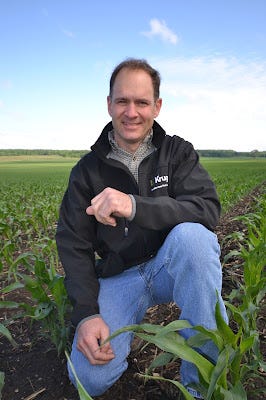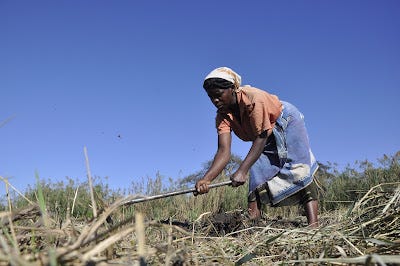Food: trading away our future - Part III
Because of productivity gains in developed countries, agriculture prices dropped by some 60% in the period 1960-2000. As the productivity of the poorest farmers remained much the same, it is obvious that they have lost out. Their value of production, regardless if they eat it themselves or sell it, has gone down considerably, making them poorer both in relative and absolute terms.
In two previous posts I discussed the impact of the rapid growth of international trade in food and agriculture commodities. This globalization of food commodities has led to, or enabled, an increasing disconnection between human populations and the land and water resources that support them through crop and livestock production. The increase in trade has big environmental repercussions as well as a big social and cultural impact. Trade is not only a response to market demand, it creates demand and therefore recreates the need for it; trade becomes its own justification.
In this post I will discuss the impact on producers from the global competition.
According to economic theory, poor countries should compete in trades that require a high labor input and have low capital requirements. Historically, agriculture has been such a sector. But today’s agriculture, in the rich countries at least, is characterized by a low labor input and very high capital input. Mechanization has crushed the comparative advantage of poor countries and poor producers. Poor farmers can only be competitive in crops which have not yet been successfully mechanized, such as coffee, tea, flowers, avocadoes and green beans. At the beginning of the 1960s developing countries had a trade surplus in agricultural produce of around US$7 billion, but by the beginning of the new millennium that balance had shifted to a deficit of around US$20 billion and, if we exclude Brazil this figure is much higher, at US$27 billion.[i] [ii] It is not only the money flow that has drastically changed direction, but also the flows of calories. In the late 1960s developed and developing countries were more or less producing their own calorific needs, but in 2009, many more developing countries had become net importers of food. Sub-Saharan Africa went from a fourteen percent surplus of calories to a thirteen percent deficit.[iii]
In 2012, I visited two very different farmers; Bob Stewart in Illinois and Susan Mkandawire in Zambia. Bob farms in the Corn Belt, south of Chicago and Susan farms not far from the international airport in Zambia. They are both maize growers, and as farmers they shared worries over the weather, prices, access to labor and many other things. They were also very different, or at least they operate under very different conditions. Bob’s yields of maize are regularly more than 10,000 kg per hectare while Susan, in a good year, gets around 2,000 kg per hectare, i.e. Bob harvests more than five times as much per area unit. That is remarkable. But what is much more remarkable is how much land they farm; Bob’s farm is 3,200 hectares while Susan manages less than half a hectare.

Bob grows maize in Pana, IllinoisBob works the farm with a brother and three full time employees, their father and Bob’s wife are also involved in the operation. In peak season they have four more helpers; each person thus manages more than 400 hectares, i.e. they spend less than five hours of work to manage the total land area that Susan farms with her husband, Fred. Because they are very poor, Fred takes on other jobs outside the farm when he finds them; at the time of my visit he was occasionally working as a watchman. Apart from the maize they also grow vegetables which are sold in the market in Zambia’s capital Lusaka. But let’s focus on the maize. Together they spend some 266 hours per year tending their 0.4 hectares of maize. They hire a team of oxen to do the land preparation; which saves them 120 hours on land preparation by hand, still the dominant method in Sub-Saharan Africa.

Susan grows maize in Zambia
Through the ease of transportation and storage (mainly driven by the fossil fuel economy), there is more or less a global market for grains, pulses and oil crops, with similar prices all over the world, tariffs or other government interventions being the only other factor of importance. These prices are determined by the producers who can combine large areas with mechanization, i.e. those than can use a lot of resources and a lot of external energy. The dramatic increase in labor productivity we have seen in the farm sector is linked to the increased use of external energy sources, be it for pumping water, driving tractors and combine harvesters or making chemical fertilizers. It is almost self-evident that Susan in Zambia has not a chance in hell of competing with Bob in Illinois. This example begs the question of whether global food markets really work to our advantage. Poor people and poor countries are supposed to get a comparative advantage from low labor costs. But this mechanism is totally broken when the cost for labor is depressed far below sustenance levels, not to speak about reproduction, that is raising a family. Because of productivity gains in developed countries, agriculture prices dropped by some 60% in the period 1960-2000. As the productivity of the poorest farmers remained much the same, it is obvious that they have lost out. Their value of production, regardless if they eat it themselves or sell it, has gone down considerably, making them poorer both in relative and absolute terms.
(this post is almost entirely drawn from my book Global Eating Disorder)
[i] Regmi, A. and M. Gehlhar (editors) 2005 ‘New Directions in Global Food Markets’, USDA Agriculture Information Bulletin Number 794.
[ii] FAO 2007 The State of Food and Agriculture 2007 Food and Agriculture Organization of the United Nations.
[iii] FAO 2012 Statistical Yearbook 2012. FAO Statistics Division Metalink: P2.HUN.FAO.TFS.SSCAL, p. 165
[iv] National Cotton Council of America 2013 US and World Cotton Outlook September 2013 NCCA.



